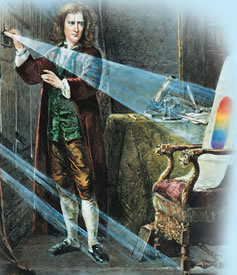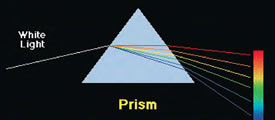
Dimdima
Online Children's Magazine from India

Dimdima
Online Children's Magazine from India

Light, and the technologies that have developed around it, play an important role in our lives. Light is linked to sight. Also, all the food we eat is the end product of a reaction brought about by light. So it is befitting that the world education body of the United Nations has decided to focus public attention on this great benefactor of mankind by celebrating 2015 as the International Year of Light and Light-based Technology.
NO talk or article on light would be complete without mention of the famous scientist Sir Isaac Newton.
Newton was born on 4 January, 1643 in Woolsthorpe in England. His father was a wealthy farmer. He felt neglected by his mother, and by all accounts his childhood was an unhappy one.
School bored him and his teachers rated him as a poor student. When he was 18 years old, he went to Cambridge University where he became interested in optics, physics, mathematics and astronomy. He spent all his spare time studying these subjects. But as in school, so in college, he gave no indication of the brilliance of mind that was to distinguish him in later life. In 1665, the University shut down due to an outbreak of plague. Newton returned home and continued to pursue his studies on his own. His wide range of interests and his innate curiosity led him to ponder over questions of everyday life, like for instance why oil spilt on the ground sometimes reflected several colours. He went around with a notebook filling the pages with notes as he read and experimented.
Once while strolling through a village fair, he spotted a set of prisms which were up for sale, glistening in the sun. An idea occurred to him. He bought the prisms and took them to a room in his house which was lit up by light streaming in from a single window.
Placing a prism on a table he adjusted the shutters so that a beam of light passed through the prism. After passing through the prism, the light fell on a wall about 7 metres away and formed on it a rectangular patch consisting of seven colours. This greatly excited Newton. Was it the prism that was giving various colours to the light? Or was the light itself made up of seven colours  that separated when passed through a prism? He did the experiment again and again and came to the conclusion that light is a blend of seven colours.
that separated when passed through a prism? He did the experiment again and again and came to the conclusion that light is a blend of seven colours.
The seven colours correspond to the seven colours of the rainbow. It became clear to Newton that a rainbow was formed when light passed through droplets of water that
acted as prisms. He thus became the first scientist to understand how a rainbow was formed.
Another conclusion he drew from his experiments and observations was that an object gets its colour from the colour it is unable to absorb. For example, grass is green
because it can absorb all colours of white light except green which it reflects thus bestowing on grass a green colour.
In 1704, he published his great work, ‘The Opticks’, which dealt with light and colours. During the two years he spent at Woolsthorpe because his college was shut,
Newton also became interested in gravity but light continued to attract his curiosity and he studied the properties of light in great detail. He would spend months in a darkened room doing experiments on light. Sometimes he would stare at the sun and then shift his gaze to a blank wall to try to understand why he saw the dark patterns on the wall. This would render him temporarily blind and then he would spend days in a darkened room till he regained his vision.
Our modern understanding of light and colour began with Isaac Newton and it is most fitting to remember him as the founding father of optics while celebrating the International Year of Light and light based technology – 2015.
Newton’s other major contributions to light were the Colour Wheel in 1609 and the Reflective Telescope in 1668.
● In 1678, he formulated his three laws of motion in Principia Mathematica, which laid the foundation for the science of classical mechanics and the laws of
universal gravitation. These influenced the scientists’ view of the universe for the next three centuries.
● He invented Calculus, a branch of mathematics (also invented independently by Leibniz).
— Dr. A. P. Jayaraman
EXPLORE MORE...
Get Help or Give Help.
- Do you have a Science Question?
- Post it here and get the answer.
- Some questions posted by others are not yet answered.
- View those questions and answer them.
Dimdima is the Sanskrit word for ‘drumbeat’. In olden days, victory in battle was heralded by the beat of drums or any important news to be conveyed to the people used to be accompanied with drumbeats.
Bharatiya Vidya Bhavan
K. M Munshi Marg,
Chowpatty, Mumbai - 400 007
email : editor@dimdima.com
Bharatiya Vidya Bhavan
505, Sane Guruji Marg,
Tardeo, Mumbai - 400 034
email : promo@dimdima.com
Dimdima.com, the Children's Website of Bharatiya Vidya Bhavan launched in 2000 and came out with a Printed version of Dimdima Magazine in 2004. At present the Printed Version have more than 35,000 subscribers from India and Abroad.